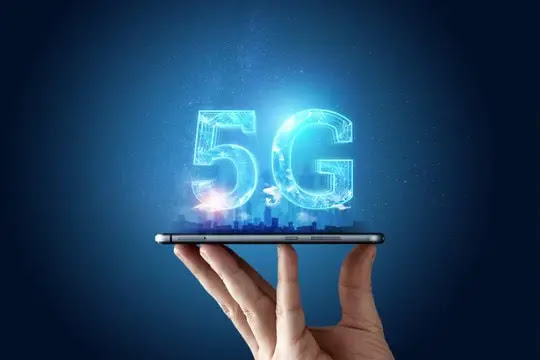Overview:
5G network has the capability to provide ultra fast data transfer rates, which can be up to 20 times faster than those of 4G networks. This allows for the development of new applications and services that were previously impossible or challenging to achieve with older communication technologies, including virtual reality, augmented reality, and cloud gaming.
Difference b/w 5G and previous generations 3G,4G:
There are several key differences between 5G and the previous generations of wireless technology, including 2G, 3G, and 4G.
Here is a table that highlights proper difference:
| Generation | Data Transfer Rates | Latency | Network Capacity | Key Features |
|---|---|---|---|---|
| 2G | Up to 50 Kbps | 300-1000 ms | Low | Voice calls, text messaging |
| 3G | Up to 2 Mbps | 100-500 ms | Moderate | Video calling, mobile internet |
| 4G | Up to 100 Mbps | 30-50 ms | High | Mobile broadband, HD video streaming |
| 5G | Up to 20 Gbps | 1 ms | Very High | Ultra-fast internet, low latency, support for IoT and real-time applications |
Top Benefits of 5G:
- Faster Data Transfer Rates
- Low Latency
- High Network Capacity
- Improved Connectivity for IoT devices
- Enables Innovative Applications
- Economic Growth
How does 5G works:
5G technology uses high frequency radio waves and advanced antenna systems to provide faster data transfer rates and lower latency compared to previous wireless communication technologies. In addition, it utilizes massive MIMO and small cells to enhance the reliability and speed of wireless communication.
These features enable a wide range of innovative applications and services, such as cloud gaming, smart cities, and remote surgeries.
Architecture:
The architecture of the 5G network is intended to be more flexible and adaptable than earlier generations of wireless communication technology.
It consists of three main components: the Radio Access Network (RAN), the Core Network (CN), and the User Equipment (UE).
- The RAN is responsible for connecting the user's device to the network and consists of multiple small cells, which are distributed throughout the coverage area.
- CN provides the core functionality of the network, including session management, authentication, and security.
- UE is the user's device, which can include smartphones, tablets, and other mobile devices.
Comparison of 5G with traditional wired networks:
Although 5G networks provide faster data transfer rates and lower latency than conventional wireless networks, they are still not as fast or reliable as traditional wired networks. Wired networks typically use fiber-optic cables to transmit data, which offer greater bandwidth and more dependable connections than wireless networks.
5G Use Cases:
This has the potential to revolutionize the way we live and work also have a great impact on various industries, such as healthcare, transportation, manufacturing, and entertainment.
Applications of 5G in different industries:
Smart Cities:
5G can be used to power smart city applications such as traffic management, waste management, and public safety.
Remote Healthcare:
It can enable remote healthcare services, including remote patient monitoring and telemedicine, by providing high-quality video and audio communication and low-latency connections.
Augmented and Virtual Reality:
It can provide the bandwidth and low latency required for immersive augmented and virtual reality experiences.
Autonomous Vehicles:
5G can support the reliable and low-latency communications needed for autonomous vehicles to safely navigate roads.
Industrial Automation:
5G can enable real-time monitoring and control of industrial processes, improving efficiency and productivity.
Cloud Gaming:
5G can provide the low latency and high bandwidth required for cloud gaming, allowing users to play games on mobile devices with minimal lag.
These are just a few examples of the many potential use cases for 5G technology, which is expected to revolutionize many industries and enable new applications and services that were previously impossible.
potential impact of 5G on society and the economy:
| Potential Impact | Description |
|---|---|
| Enhanced Connectivity | 5G will provide faster and more reliable connectivity, enabling new applications and services. |
| Innovation | 5G will enable the development of new technologies, transforming industries and creating new business opportunities. |
| Job Creation | 5G technology will create new jobs in industries such as telecommunications, software development, and data analytics. |
| Improved Healthcare | 5G will enable remote healthcare services, improving access to healthcare and reducing costs. |
| Environmental Impact | 5G can be used to reduce energy consumption and greenhouse gas emissions through smart city technologies and process optimization. |
Future developments and advancements in 5G technology:
Network Slicing:
Network slicing enables the creation of multiple virtual networks on a single physical 5G network, allowing operators to customize services to specific industries and use cases.
Edge Computing:
Edge computing is a technology that enables data processing and storage to take place closer to the source of data, reducing latency and improving performance. 5G networks will enable the deployment of edge computing at scale.
Increased Speed and Bandwidth:
While 5G networks are already fast, there is potential for further increases in speed and bandwidth as the technology matures and more spectrum becomes available.
Multi-Access Edge Computing (MEC):
MEC combines edge computing with 5G networks to create a more distributed architecture, allowing for faster processing and lower latency.
Integration with IoT:
5G networks will enable the deployment of large scale Internet of Things (IoT) applications, providing connectivity to billions of devices and enabling new use cases.
Conclusion:
To sum up, 5G technology is a major breakthrough in wireless communication that offers superior speed, reduced latency, and greater capacity when compared to earlier wireless technologies.
Despite worries over the safety and security implications of 5G, efforts are underway to tackle these concerns through continuous research and development. Additionally, the numerous advantages of 5G, such as improved connectivity, technological advancements and employment opportunities.







0 Comments